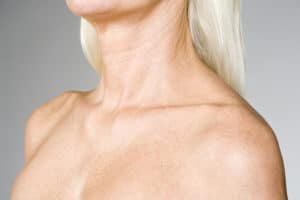
What Causes the Chest Skin to Age?
The factors that affect the face affect the neck and chest as well. Skin everywhere changes over time because the body’s production of collagen and elastin, the chemicals that firm and smooth the skin, declines sharply during early adulthood. We aren’t usually aware of this decline when it happens. It can take over a decade for the signs of aging to make themselves obvious. During that time, we may be exposing ourselves to various factors that age the delicate skin of the décolletage. These include:
- Sun exposure. Have you noticed spots across your chest? Fine lines or crepe-like skin? These are signs of sun damage. For some people, sun damage looks like a perpetual mild sunburn on the chest.
- Gravity and movement. We don’t often discuss how daily living can cause the skin to become weak and saggy. For women, especially, gravity and movement can affect the appearance of chest skin due to the additional weight of the breasts.
- When we think of air pollution, we usually think about how it may affect the lungs or even the eyes. The skin? Not so much. However, pollution in the air touches the skin. If you smoke or are around secondhand smoke, the toxic chemicals may be directly against your skin frequently, degrading collagen and causing oxidative stress.
What to Do About Your Aging Chest
Aging is not something to address once it happens. Remember, we pointed out that we don’t begin to see the effects of cosmetic aging until about 10 years after the body has slowed its production of collagen and elastin. During that time, instead of continually exposing ourselves to the factors that age the skin, we can become protective. Protection looks like:
- Wearing sunscreen on the chest (and neck and face) every day. Choose a broad-spectrum, SPF 30 sunscreen.
- Don’t tan. Not at the beach or pool, and not in a tanning bed.
- Care for the neck and chest just as the face, using quality skincare with retinoids and antioxidants and exfoliating about once a week. Also, moisturize, moisturize, moisturize!
If your chest is showing the signs of aging or you’d like to get a jump start on supporting aging chest skin, contact our Sonterra or La Casita office. We’ve got options for you!
